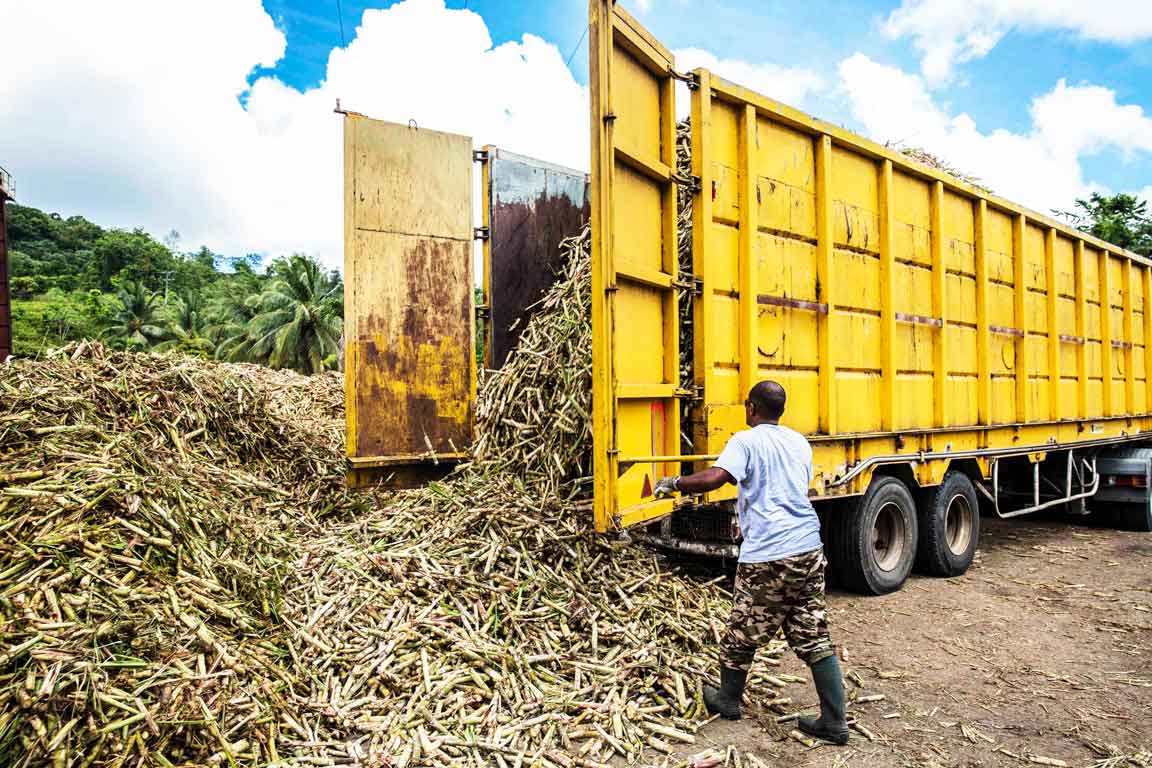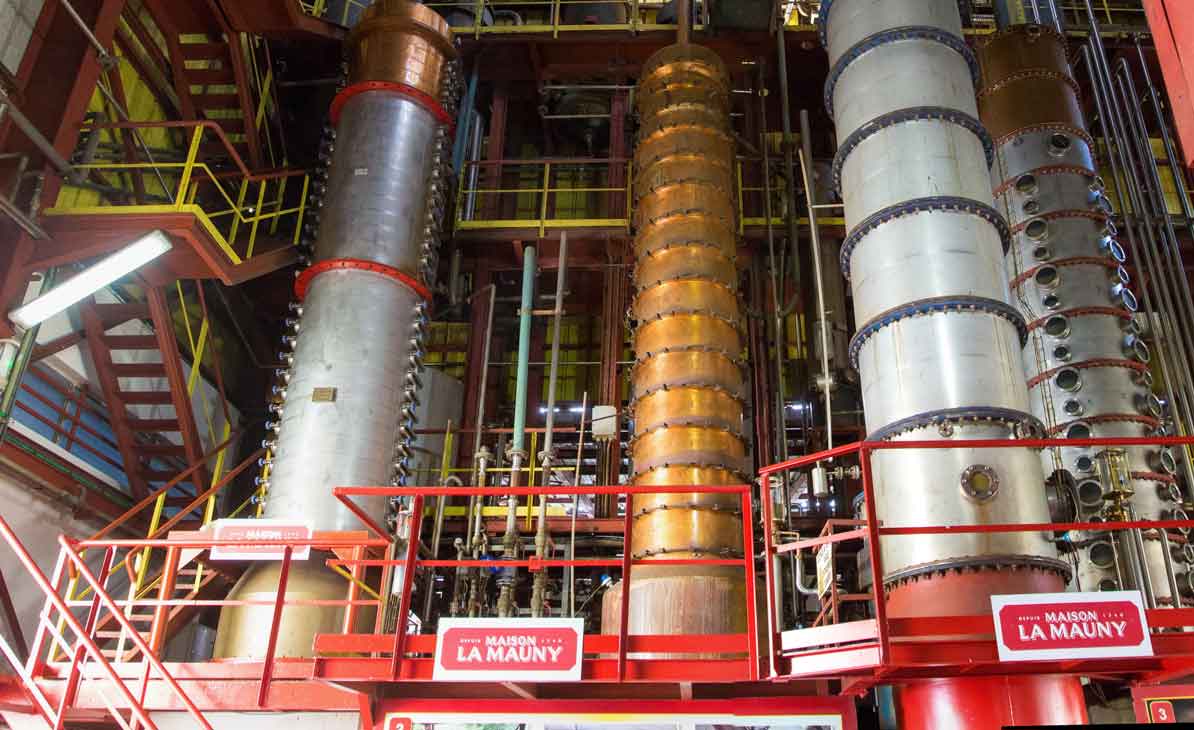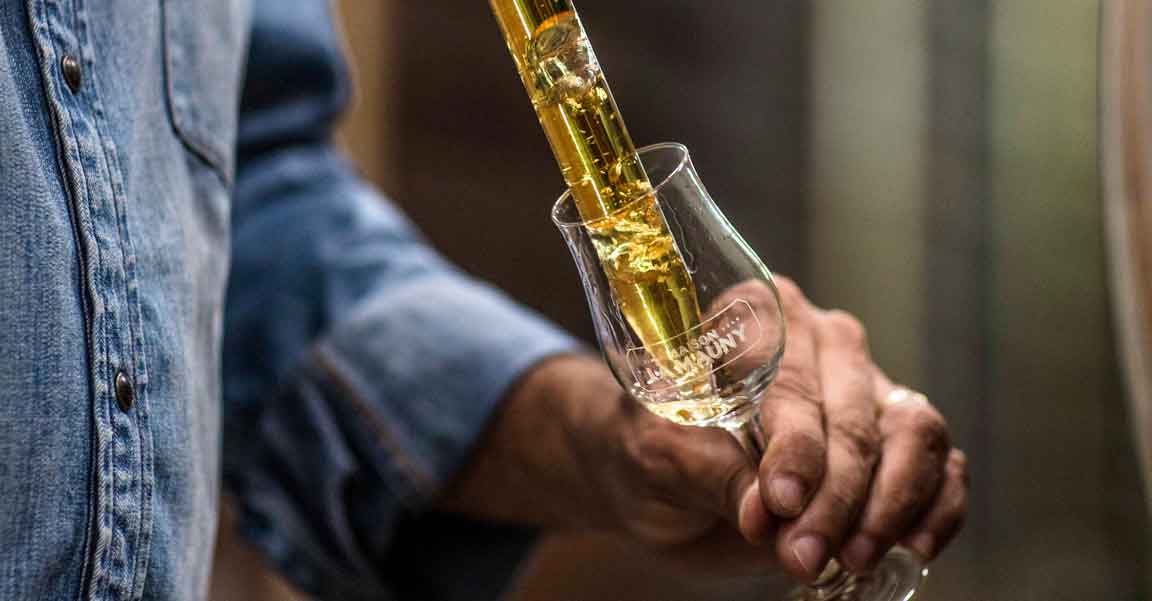Manufacturing
Manufacturing
stages
Agricole Rum Production
Agricole rum is obtained after the fermentation and distillation of pure sugarcane juice.
Only 5% of rum’s worldwide production is made with the juice of pure sugarcane; the other 95% being made from molasses (refined sugarcane residue).
Sugarcane Harvesting
In Martinique, February marks the beginning of the rum making activity: cutting the sugarcanes and activating the distilleries.
The Maison La Mauny domain surrounds the distillery and benefits from unique microclimate in the heart of a warm and humid green valley; it rains less and is sunnier than on the rest of the island. Combined to a volcanic, black clay soil, this great terroir gives the sugarcanes exceptional sugar concentration.
Agricole Rum Production
Agricole rum is obtained after the fermentation and distillation of pure sugarcane juice.
Only 5% of rum’s worldwide production is made with the juice of pure sugarcane; the other 95% being made from molasses (refined sugarcane residue).
Sugarcane Harvesting
In Martinique, February marks the beginning of the rum making activity: cutting the sugarcanes and activating the distilleries.
The Maison La Mauny domain surrounds the distillery and benefits from unique microclimate in the heart of a warm and humid green valley; it rains less and is sunnier than on the rest of the island. Combined to a volcanic, black clay soil, this great terroir gives the sugarcanes exceptional sugar concentration.
Collecting at the distillery
When the sugarcanes arrive at the distillery they are weighed, controlled and unloaded.
Maison La Mauny Distillery also buys 30% of its sugarcane from smaller, neighboring plantation owners who share their concern for responsible and sustainable farming.
Only the canes with exceptional sugar content are selected to make Maison La Mauny Agricole rums.
In order to facilitate the juice extraction, sugarcanes are crushed defibrated before grinding it into juice.
10kg of sugarcanes are necessary to make 1 liter of agricultural rum at 55% A.B.V.

Collecting at the distillery
When the sugarcanes arrive at the distillery they are weighed, controlled and unloaded.
Maison La Mauny Distillery also buys 30% of its sugarcane from smaller, neighboring plantation owners who share their concern for responsible and sustainable farming.
Only the canes with exceptional sugar content are selected to make Maison La Mauny Agricole rums.
In order to facilitate the juice extraction, sugarcanes are crushed defibrated before grinding it into juice.
10kg of sugarcanes are necessary to make 1 liter of agricultural rum at 55% A.B.V.
Cane crushing
The sugarcanes are crushed through several mills.
For a better extraction, the sugarcanes are sprayed with water after each crushing; the cane juice thus collected (also called vesou) is then filtered and pumped into the fermentation vats.
Cane crushing
The sugarcanes are crushed through several mills.
For a better extraction, the sugarcanes are sprayed with water after each crushing; the cane juice thus collected (also called vesou) is then filtered and pumped into the fermentation vats.
Cane crushing
The sugarcanes are crushed through several mills.
For a better extraction, the sugarcanes are sprayed with water after each crushing; the cane juice thus collected (also called vesou) is then filtered and pumped into the fermentation vats.
Fermentation
Maison La Mauny distillery possess 36 fermentation vats of a capacity of 30,000 liters each.
The sugar present in the canes combined to yeasts ferment into alcohol; it takes 24 hours to obtain sugarcane wine at 4 to 5% A.B.V. A 30,000 liter vat gives approximately 2,000 liters of Agricole rum at 55% A.B.V.
Fermentation
Maison La Mauny distillery possess 36 fermentation vats of a capacity of 30,000 liters each.
The sugar present in the canes combined to yeasts ferment into alcohol; it takes 24 hours to obtain sugarcane wine at 4 to 5% A.B.V. A 30,000 liter vat gives approximately 2,000 liters of Agricole rum at 55% A.B.V.
Fermentation
Maison La Mauny distillery possess 36 fermentation vats of a capacity of 30,000 liters each.The sugar present in the canes combined to yeasts ferment into alcohol; it takes 24 hours to obtain sugarcane wine at 4 to 5% A.B.V. A 30,000 liter vat gives approximately 2,000 liters of Agricole rum at 55% A.B.V.
Distillation
Maison La Mauny has its own distillery. Three distillation columns, among which a full-copper one, enable the distillation of the whole of Maison La Mauny Agricole rums.
Introduced into the top of the column, the sugarcane wine drops from plate to plate and is heated by the vapor introduced by the bottom of the column.
The alcohol vapor is collected at the head of the column and then cooled down.
The white Agricole rum that comes out of the column is crystal-clear. It contains between 65 and 75% alcohol by volume (A.B.V.). After the alcohol is watered down, one part will be use as white Agricole rum and the other part will be put to age in oak wood in order to become gold or aged Agricole Rums.

Distillation
Maison La Mauny has its own distillery. Three distillation columns, among which a full-copper one, enable the distillation of the whole of Maison La Mauny Agricole rums.
Introduced into the top of the column, the sugarcane wine drops from plate to plate and is heated by the vapor introduced by the bottom of the column.
The alcohol vapor is collected at the head of the column and then cooled down.
The white Agricole rum that comes out of the column is crystal-clear. It contains between 65 and 75% alcohol by volume (A.B.V.). After the alcohol is watered down, one part will be use as white Agricole rum and the other part will be put to age in oak wood in order to become gold or aged Agricole Rums.
Blending
and aging
In Martinique the warm weather speeds up to three times the ageing process, compared to continental ageing. Gold Agricole rums are aged in oak tons for 12 to 18 months, which is what gives them their light golden color. Aged Agricole rums spend at least 3 years in oak casks, mainly French, new or ex Cognac casks; Hors d’Age and Millésimes spend at least 6 years in oak casks before being bottled.
In the Cellars, time and know-how are both necessary to exalt the flavors of Maison La Mauny Agricole rums.
Day after day the Cellar Master watches over our precious Agricole Rum casks. He patiently tastes and takes note of the evolution of each one, supervises their aging and seeks for the right balance. The art of blending then gets all its meaning; the Cellar Master combines different vintages into a single bottle and gives them a special finish.
Blending
and aging
In Martinique the warm weather speeds up to three times the ageing process, compared to continental ageing. Gold Agricole rums are aged in oak tons for 12 to 18 months, which is what gives them their light golden color. Aged Agricole rums spend at least 3 years in oak casks, mainly French, new or ex Cognac casks; Hors d’Age and Millésimes spend at least 6 years in oak casks before being bottled.
In the Cellars, time and know-how are both necessary to exalt the flavors of Maison La Mauny Agricole rums.
Day after day the Cellar Master watches over our precious Agricole Rum casks. He patiently tastes and takes note of the evolution of each one, supervises their aging and seeks for the right balance. The art of blending then gets all its meaning; the Cellar Master combines different vintages into a single bottle and gives them a special finish.




